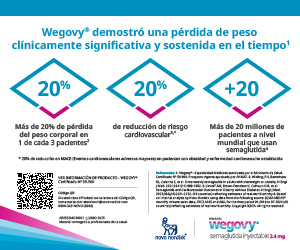P32 Salvia hispanica L. (chia) seed promotes the reduction of body fat and improves lipid metabolism disorders in the white adipose tissue of rats fed a sucrose rich diet
DOI:
https://doi.org/10.47196/diab.v54i3Sup.417Keywords:
chia, reduction of body fat, improves lipid metabolism disordersAbstract
Introduction: In recent years, several studies have focused on the mechanisms involved in the accumulation of visceral fat and its role in the pathophysiology of Metabolic Syndrome, in order to find therapeutic strategies for its prevention and/or treatment. In this sense, the Salvia hispanica L. (chia) seed has generated great interest as a source of bioactive compounds (α-linolenic acid, fibers, high-quality proteins, vitamins, minerals and antioxidants).
Objectives: To analyze the effects of chia seed on the metabolic pathways that play a key role in white adipose tissue lipids handling and that could be involved in the reduction of visceral adiposity developed in rats fed a sucrose rich diet (SRD).
Materials and methods: Male Wistar rats were fed a reference diet (RD) -6 months- or a SRD -3 months. Then the last group was randomly divided into two subgroups. One subgroup continued to receive SRD until 6 months and the other received a SRD where whole chia seed was incorporated as a source of fat for the next 3 months (SRD+CHIA). At the end of the experimental period, the following were analyzed in epididymal adipose tissue: lipogenic (ATP citrate lyase ATP CL, Fatty Acid Synthase FAS, Phosphoenol Pyruvate carboxykinase PEPCK, Malic Enzyme EM and Acetyl CoA carboxylase ACC) and oxidative (Carnitine Pamitoyl transferase CPT) enzymes activities, protein mass levels of FAT/CD 36, SREBP-1c, totalAMPK, pAMPK and PKCβ. In addition, biometrical parameters, energy intake, carcass composition, serum lipids, visceral adiposity, and lipid content in adipocytes were determined. Euglycemic-hyperinsulinemic clamp.
Results: They are expressed as mean ± SEM (n = 6) and were analyzed by ANOVA and Newman Keuls post test. ATP CL (mU/mg protein): RD: 2.15 ± 0.10, SRD: 4.56 ± 0.40*, SRD+CHIA: 2.63 ± 0.24; ACC (mU/mg protein): RD: 26.96 ± 2.85, SRD: 25.82 ± 2.51*, SRD+CHIA: 26.50 ± 1.75; FAS (mU/mg protein): RD: 14.35 ± 1.12, SRD: 18.05 ± 0.85*, SRD+CHIA: 14.32 ± 0.61; G-6-P DH (mU/mg protein): RD: 30.55 ± 2.15, SRD: 49.40 ± 4.30*, SRD+CHIA: 33.30 ± 2.45, PEPCK (mU/mg protein): RD: 2.01 ± 0.21, SRD: 3.19 ± 0.13*, SRD+CHIA: 1.78 ± 0.22, without changes in ACC, ME, CPT-1, 2 and total; SREBP-1 precursor: RD: 100 ± 3, SRD: 135 ± 15*, SRD+CHIA: 74 ± 12#, SREBP-1 mature: RD: 99 ± 4, SRD: 144 ± 13*, SRD+CHIA: 40 ± 12#, pAMPK: RD: 100.04 ± 0.33, SRD: 83.94 ± 6.32 *, SRD+CHIA: 94.4 ± 2.5 (no change in totalAMPK). * P<0.05 SRD
vs. RD and SRD+CHIA; #P <0.05 SRD+CHIA vs. RD and SRD. The results showed that chia seed reduced abdominal and thoracic circumference, carcass fat content, adipose tissue weight, and visceral adiposity index. This was accompanied by an improvement in insulin sensitivity and plasma lipid profile. In epididymal adipose tissue, the decrease in the triglyceride content of fat cells was
associated with a reduction in both the protein mass levels of FAT/CD 36 and lipogenic enzymes activities. No changes were observed in the oxidative enzyme CPT activities. The precursor and mature forms of SREBP-1 and PKCβ protein levels decreased while pAMPK increased.
Conclusion: Our findings suggest that chia seed administration can modulate important parameters of lipid metabolism in adipose tissue, which would be associated with its reducing effect on visceral fat accumulation observed in rats fed SRD.
Downloads
Published
Issue
Section
License

This work is licensed under a Creative Commons Attribution-NonCommercial-NoDerivatives 4.0 International License.
Dirección Nacional de Derecho de Autor, Exp. N° 5.333.129. Instituto Nacional de la Propiedad Industrial, Marca «Revista de la Sociedad Argentina de Diabetes - Asociación Civil» N° de concesión 2.605.405 y N° de disposición 1.404/13.
La Revista de la SAD está licenciada bajo Licencia Creative Commons Atribución – No Comercial – Sin Obra Derivada 4.0 Internacional.
Por otra parte, la Revista SAD permite que los autores mantengan los derechos de autor sin restricciones.




























